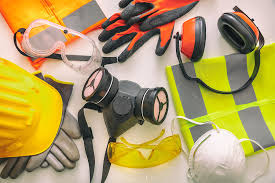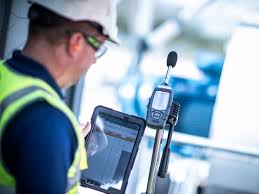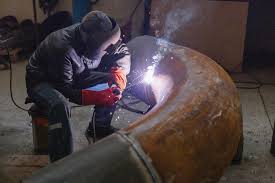Industrial Hygiene Services
Hazard Exposure Assessments & Workplace Safety Solutions
Our Industrial Hygiene services safeguard worker health by identifying, evaluating, and controlling workplace environmental hazards. We develop customized plans based on detailed assessments and regulatory compliance to ensure a safe working environment.
What is Industrial Hygiene?
Industrial hygiene services protect and enhance worker health through identifying, evaluating, and controlling environmental hazards in the workplace that impair health, cause sickness, or contribute to significant discomfort among employees.

Comprehensive Workplace Safety Solutions
Our expert team provides comprehensive industrial hygiene assessments to identify potential workplace hazards and develop effective control strategies. We work with businesses across various industries to ensure compliance with OSHA regulations and protect employee health.
Air Monitoring Services
Air monitoring, a vital service of industrial hygiene, involves the detection and quantification of airborne hazards, including welding fumes, hexavalent chromium, silica, respirable dust, and volatile organic compounds (VOCs) emanating from paint booths.
Setting Up an Air Monitoring Study
We design an air monitoring study to meet each organization's unique requirements. It begins by evaluating the chemicals used in the facility and the types of particulate matter employees may be exposed to. We work with clients to understand their manufacturing processes, the activities performed (i.e., welding, painting, cutting, grinding), and the facility's layout.
We review safety data sheets to identify the chemicals requiring monitoring and to understand where respiratory protection may be necessary. These sheets also detail the permissible exposure limits, guiding the monitoring process to ensure compliance with established safety standards.
Common Airborne Hazards We Monitor:
From Monitoring to Corrective Action
The data collected is analyzed post-monitoring, and we generate a comprehensive report. This report outlines the findings for each individual and area monitored, offering recommendations based on the levels of exposure observed.
Should the results indicate exposure at or above the action level or permissible exposure limit, tailored advice is provided on mitigating the risks to employees, from implementing engineering controls to adjusting work practices and using personal protective equipment (PPE).
Initial Assessment
Comprehensive facility evaluation and hazard identification
On-Site Monitoring
Professional air sampling using calibrated equipment
Detailed Reporting
Comprehensive analysis with actionable recommendations
Noise Monitoring
Noise monitoring involves assessing the sound levels within a workplace to prevent hearing loss and other auditory issues among workers. This type of exposure not only causes immediate discomfort but can also lead to serious long-term health issues such as permanent hearing loss, stress, and heart disease.
Recommendations for hearing protection, annual audiograms, and adjustments to the workplace environment are part of the corrective actions following noise monitoring.
Health Risks of Noise Exposure:
- • Permanent hearing loss
- • Increased stress levels
- • Cardiovascular disease
- • Reduced productivity
- • Communication difficulties

Our Noise Monitoring Process
Initial Assessment
Quick evaluation using uncalibrated equipment to identify potential noise hazards and high-risk areas.
Calibrated Monitoring
Precise measurement using calibrated noise dosimeters during full work shifts to determine actual exposure levels.
Control Implementation
Development of engineering controls, administrative measures, and PPE recommendations to reduce exposure.
Silica Monitoring
Silica, a common mineral in various construction materials like sand and concrete, presents significant health hazards when its fine particles are inhaled. These particles can potentially cause severe diseases such as silicosis and lung cancer.
Why Silica Monitoring is Critical
Given these risks, industries such as construction and stone cutting require stringent monitoring of airborne silica to safeguard worker health and comply with occupational safety regulations. The adverse health outcomes associated with prolonged exposure to respirable crystalline silica highlight the necessity of monitoring.
OSHA mandates precise silica exposure limits, which necessitate rigorous monitoring. Such customized silica monitoring is a fundamental component of industry-specific health and safety protocols.
Health Risks of Silica Exposure
- Silicosis (progressive lung disease)
- Lung cancer
- Chronic obstructive pulmonary disease (COPD)
- Kidney disease
Industries Requiring Silica Monitoring
Construction Industry
Concrete cutting, drilling, grinding, and demolition activities
Stone Working
Cutting, shaping, and polishing natural and engineered stone
Manufacturing
Foundries, glass manufacturing, and ceramic production
Mining & Quarrying
Extraction and processing of silica-containing materials
Safety management strategies will incorporate engineering controls and protective measures based on the monitoring outcomes to mitigate silica exposure. These comprehensive measures allow you to meet legal and regulatory requirements and significantly improve your employees' health and safety conditions.
Request Silica AssessmentWelding Fumes Monitoring
Welding processes, utilized in many industries, release a mix of metal fumes and gases that are harmful to health, necessitating monitoring to protect workers and comply with safety regulations. Substances like hexavalent chromium, manganese, lead, and aluminum found in welding fumes pose severe health risks, including respiratory and neurological disorders.
Hazardous Substances in Welding Fumes:
Regulations set specific permissible exposure limits (PELs) for the dangerous substances in welding fumes, mandating companies monitor these emissions to ensure workplace safety and avoid legal penalties.

Comprehensive Welding Fumes Assessment
A comprehensive welding fumes monitoring program involves identifying metals present and assessing their concentrations during welding tasks. This data is vital for crafting strategies to control exposure and safeguard worker health.
Metal Identification
Comprehensive analysis to identify specific metals and their concentrations in welding fumes.
Exposure Control
Development of strategies including ventilation systems and protective equipment recommendations.
Worker Training
Education programs on health risks and preventive measures to enhance safety protocols.
At Safety Consultants USA, we stress the importance of exposure control strategies and employee education to mitigate risks associated with welding fumes. Recommendations include installing local exhaust ventilation, using alternative materials, and ensuring workers wear personal protective equipment.
Schedule Welding AssessmentRisks of Paints and Coatings
Managing hazards linked to paints and coatings—such as solvents, urethanes, and epoxies—is essential due to their prevalence in various industries and potential health risks from chemical exposure.
Chemical Hazards in Paint Products
These materials, including volatile organic compounds (VOCs) and isocyanates, pose significant dangers through inhalation and direct contact. Monitoring these risks in industrial settings is crucial, as these substances can affect employee health adversely, leading to conditions ranging from respiratory irritation to more severe reactions like asthma.
Volatile Organic Compounds (VOCs)
Can cause headaches, dizziness, and long-term organ damage
Isocyanates
Highly reactive chemicals that can trigger asthma and respiratory sensitization
Heavy Metals
Lead, chromium, and other metals in specialty coatings
Our Monitoring Approach:
Our industrial hygiene services ensure that workplaces adhere to established safety standards, protecting workers from immediate and long-term health issues. Monitoring air quality for VOCs and particulates in areas where these substances are used is a primary method to maintain safe exposure levels.
Control Measures & Safety Protocols
Implementing control measures based on air quality data, such as improved ventilation and using safer materials like water-based paints, will reduce potential health risks.
Engineering Controls
- • Local exhaust ventilation systems
- • Spray booth installations
- • Air filtration systems
Personal Protective Equipment
- • Respiratory protection programs
- • Chemical-resistant gloves
- • Protective clothing and eyewear
Training & Education
- • Safe handling procedures
- • Health hazard awareness
- • Emergency response protocols
Employee education on the safe handling of paints and coatings, along with the consistent use of personal protective equipment (PPE), is fundamental to ensuring safety in the workplace. Regular training on the health hazards associated with these substances and the correct usage of PPE helps safeguard against exposure.
Get A Painting Protocol AssessmentA Comprehensive Approach to Industrial Hygiene and Safety
HP Inc Consultant Services takes a meticulous and comprehensive approach to ensure workplace health and safety through its industrial hygiene services. The process involves several key steps, from initial assessment to implementing changes, training workers, and ongoing facility monitoring.
Initial Facility Assessment and Dialogue
The process begins with an in-depth evaluation of the facility. We engage in detailed discussions with clients to understand their operations, chemicals used, and potential employee exposures. By reviewing facility maps and discussing specific activities like welding, painting, or grinding, consultants can pinpoint areas of concern.
Review of Safety Data Sheets and Identification of Hazards
The assessment phase involves reviewing safety data sheets for all chemicals used within the facility to determine which substances require monitoring and to understand where respiratory protection might be needed.
Conducting On-Site Monitoring
Following the initial assessment, we schedule a day to conduct on-site monitoring. Our industrial hygiene consultants use specialized equipment to monitor air quality and noise levels, focusing on areas and employees identified during the assessment phase.
Analysis of Results and Report Generation
Once we complete monitoring, the collected data is analyzed directly or sent to a laboratory for processing. We then compile a comprehensive report detailing individual and area-specific results with recommendations for mitigating exposure to identified hazards.
Development and Implementation of Corrective Action Plans
Based on the findings of the monitoring report, we work with clients to develop and implement corrective action plans. These plans may involve installing new ventilation systems, adjusting work processes to minimize exposure, or introducing specific types of PPE.
Worker Training and Education
An essential component of the corrective action plan involves training and educating employees about the identified hazards, the importance of the implemented changes, and how to use PPE correctly. We provide comprehensive training sessions covering exposure-related health implications.
Ongoing Monitoring and Reassessment
We recommend ongoing facility monitoring to ensure the continued effectiveness of implemented changes. This work may include regular air and noise monitoring to assess the impact of new equipment or changes in production processes.
Why Choose Our Comprehensive Approach?
- Tailored solutions for your specific industry and operations
- Regulatory compliance and risk management expertise
- Ongoing support and continuous improvement
Industrial Hygiene Services Across Multiple Industries
HP Inc Consulting Services offers comprehensive industrial hygiene services tailored to the unique needs of heavy civil construction, transportation infrastructure, structural steel, and specialized industrial operations. Each sector faces specific challenges and risks, requiring specialized approaches to ensure worker health and safety.
Heavy Civil Construction
Industries:
Bridge construction, highway projects, tunnels, dams, and large-scale transportation infrastructure.
Services Utilized:
Silica monitoring for concrete work, noise monitoring for heavy machinery, air quality assessments for confined spaces and excavations.
Why They Need It:
Essential for protecting workers from respiratory hazards, noise-induced hearing loss, and ensuring compliance with OSHA standards for large-scale projects.
Structural Steel and Fabrication
Industries:
High-rise construction, industrial facilities, bridge structures, and commercial steel fabrication.
Services Utilized:
Welding fume monitoring, hexavalent chromium assessments, noise monitoring for cutting and grinding operations.
Why They Need It:
Critical for controlling exposure to carcinogenic welding fumes and protecting workers from respiratory diseases and hearing damage.
Transportation Infrastructure
Industries:
Railway systems, airport construction, port facilities, and mass transit projects.
Services Utilized:
Comprehensive air monitoring for diesel exhaust, noise assessments for heavy equipment, and confined space evaluations.
Why They Need It:
Ensures worker protection in complex environments with multiple hazards and maintains compliance with federal transportation safety standards.
Specialized Coating and Painting
Industries:
Bridge painting, industrial coating, automotive refinishing, and infrastructure maintenance.
Services Utilized:
Air monitoring for VOCs, lead paint assessments, and respiratory protection evaluations.
Why They Need It:
Critical for minimizing exposure to toxic chemicals and ensuring compliance with EPA and OSHA regulations for coating operations.
Specialized Services for Large-Scale Projects
Infrastructure Development
Projects: Major highway construction, bridge rehabilitation, tunnel boring, and port expansion
Services: Comprehensive exposure assessments, confined space monitoring, and multi-phase project safety evaluations
Purpose: Ensure worker safety across complex, multi-year infrastructure projects with evolving hazards
Heavy Industrial Operations
Operations: Steel mills, power plants, petrochemical facilities, and large-scale manufacturing
Services: Process-specific monitoring, emergency response planning, and regulatory compliance assessments
Purpose: Maintain safe operations in high-risk industrial environments with complex regulatory requirements
Industrial hygiene services are fundamental to maintaining safe working environments across heavy civil construction, transportation infrastructure, structural steel, and specialized industrial operations. By providing comprehensive monitoring, analysis, and training, we help businesses protect their employees from potential health hazards while ensuring regulatory compliance.
Get Industry-Specific AssessmentGet Your Industrial Hygiene Assessment
Contact us today to schedule a comprehensive industrial hygiene assessment for your facility. Our experts will work with you to identify hazards and develop effective control strategies.
Call Us
877-723-7622
Response Time
Within 24 hours
Certified Experts
OSHA Compliant